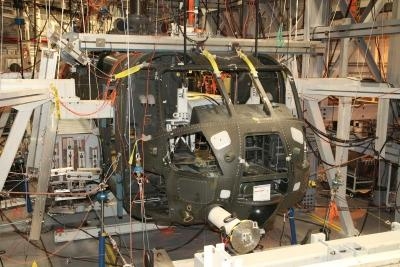Static Tests Conducted On Non-Flying Airframe
Sikorsky has successfully completed an initial series of tests required by the Naval Air Systems Command to verify the structural strength of the CH-53K heavy lift helicopter. Conducted on a full-size non-flying airframe called the Static Test Article, the tests are part of a three-year program to validate that the largest helicopter ever designed and built by Sikorsky has the structural integrity to operate safely over its entire flight envelope — from its empty gross weight of 44,000 pounds up to its maximum gross weight of 88,000 pounds with external load.

"The Static Test Article will enable Sikorsky to replicate the many stresses, strains and aerodynamic forces the CH-53K helicopter will experience during all aspects of flight, whether the aircraft is empty, filled with cargo, or carrying up to 36,000 pounds of gear suspended beneath the aircraft by an external sling," said Mike Torok Sikorsky's CH-53K Program Vice President. "By placing incrementally heavier static loads on various parts of the airframe assembly — including those well beyond the airframe's analytical design strength — we can measure structural integrity, airworthiness and crash worthiness, and verify safety margins for all expected operational conditions."
The Static Test Article is housed in a specially-built test facility at Sikorsky's manufacturing plant in Stratford, CT. Consisting of the cockpit, the cabin, fuel sponsons, a transition section and the tail rotor pylon, the complete airframe assembly is suspended off the ground by the shaft of its main rotor gearbox. Surrounding support beams hold the numerous hydraulic cylinders that apply the flight and inertial loads to parts of the airframe assembly. Also attached to the STA structure are component-representative weights that simulate the presence of the engines and landing gear, among other key subsystems and components.
To date, Sikorsky has completed a total of six test conditions on the Static Test Article, all conducted during 2013 and early 2014. The first four test conditions satisfy pre-flight requirements ahead of a CH-53K flight test aircraft taking to the skies for the first time later this year. Replicating the maximum load conditions encountered while in flight, the four pre-flight tests measured the structural strength of the tail rotor pylon during high and low speed flight maneuvers, the landing gear during impact with the ground, and the full airframe structure while under maximum rotor power.
Sikorsky will continue to test the structural integrity of the CH-53K Static Test Article for another two years to validate the effects of aerodynamic forces and weight distribution on different sections of the airframe.
The Static Test Article is the first of two non-flying CH-53K test articles — along with five prototype and four production-representative heavy lift helicopters — that Sikorsky is developing as part of a $3.8 billion System Development and Demonstration (SDD) contract for the U.S. Navy.
Per the current program of record, the Marine intends to order 200 CH-53K production aircraft, and to stand up eight operational squadrons and one training squadron to support the Marine Corps' operational requirements. Eventual production quantities would be determined year-by-year over the life of the program based on funding allocations set by Congress and the U.S. Department of Defense acquisition priorities.
(Image provided by Sikorsky)
 ANN's Daily Aero-Term (04.24.24): Runway Lead-in Light System
ANN's Daily Aero-Term (04.24.24): Runway Lead-in Light System ANN's Daily Aero-Linx (04.24.24)
ANN's Daily Aero-Linx (04.24.24) Aero-FAQ: Dave Juwel's Aviation Marketing Stories -- ITBOA BNITBOB
Aero-FAQ: Dave Juwel's Aviation Marketing Stories -- ITBOA BNITBOB Classic Aero-TV: Best Seat in The House -- 'Inside' The AeroShell Aerobatic Team
Classic Aero-TV: Best Seat in The House -- 'Inside' The AeroShell Aerobatic Team Airborne Affordable Flyers 04.18.24: CarbonCub UL, Fisher, Affordable Flyer Expo
Airborne Affordable Flyers 04.18.24: CarbonCub UL, Fisher, Affordable Flyer Expo



